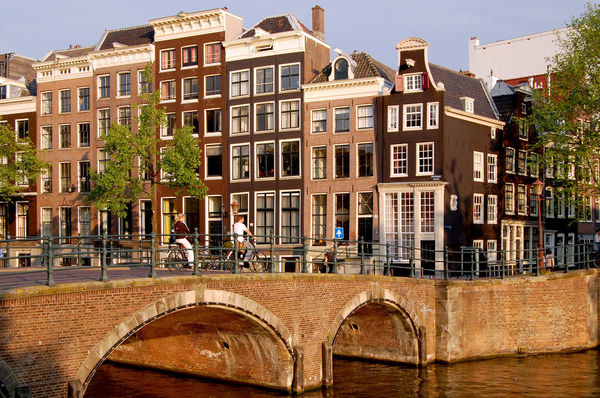Amsterdam’s Dance of Crass and Class
No matter the neighborhood, when visiting Amsterdam you’ll see sometimes-jarring juxtapositions that somehow all jive here.

By Rick Steves
Most of Europe's major cities are a mix of old and new, elegant and rough-edged, traditional and forward-looking — but the contrasts you encounter in Amsterdam are particularly extreme…and unusually fascinating. Amsterdam is a laboratory of progressive living, bottled inside Europe's most 17th-century city.
For centuries, the city has taken a tolerant approach to things other places try to forbid. In the 1600s, the Dutch golden age, Amsterdam was a fortified marina of 30,000 people — mostly merchants — who welcomed ships loaded with material delights from every corner of the trading world. The city attracted sailors and businessmen away from home, and it was profitable to allow them to have a little fun.
The Dutch had become wealthy thanks to their willingness to do business with anyone with the goods to trade — a mercantile mindset that spurred broad-mindedness, especially in the bustling boom town of Amsterdam. Meanwhile, this part of Europe was reeling from decades of intense religious battles, which had left the Low Countries not just war-weary but less disposed to pious extremism. In smaller towns, Calvinists and Catholics still went on banning each other's practices for several generations — but in the booming merchant city of Amsterdam, expediency demanded permissiveness. Jews, outcasts, political rebels, and overseas immigrants were drawn to Amsterdam by its tolerant atmosphere, which became a point of local pride.
The city has remained at least relatively free-thinking ever since. One of Europe's first gay bars opened here in 1927, and the city was naturally a magnet for Europe's hippies in the 1960s — solidifying its status as a world capital of acceptance and social experimentation. Stroll through any neighborhood and you'll see sometimes-jarring juxtapositions that are commonplace in Amsterdam. In one of its most architecturally appealing neighborhoods — what had long been the sailors' quarter — prostitutes pose in government-licensed windows. Around town, old ladies in bonnets sell fresh flowers next to "coffeeshops" where Amsterdammers of all stripes smoke boutique strains of locally grown marijuana. "Smartshops" sell psychedelic drugs down the street from cozy cafés. Overhead, carillons ring out the same tunes they've chimed for centuries.
I find Amsterdam's unpredictable street scenes — crass one moment then charming the next — at least as rewarding as the city's top-notch museums. First-time visitors certainly experience more crass than charm as they exit the main train station. Follow the crowds from the station down Damrak, the main drag leading to Dam Square, and you'll pass the same gauntlet of change bureaus, fast-food outlets, and ratty souvenir shops that cluster around most any major European station — plus the world's oldest sex museum.
But from Dam — the city's central square, where merchant ships once docked and unloaded the goods that funded Holland's prosperity — you're only blocks away from the time-capsule canal houses and bridge-laced waterways that fill most of central Amsterdam. From this square, the city spreads out like a fan in a series of concentric canals first laid out in the 17th century.
These peaceful green canals, most only about 10 feet deep, tamed the flow of the Amstel River, creating pockets of dry land to build on. A system of locks near the central train station controls the flow outward (eventually) to the North Sea, and the tides' flow inward.
Cobbled roller-coaster roads connect more than 1,200 bridges that gently arch over Amsterdam's 100-odd canals. Handsomely gabled houses, jammed into every inch of canalside space, jostle for a view of the water. As their foundations of pilings rot or settle, the comically narrow houses lean on each other, looking as if someone has stolen their crutches.
While Amsterdam's center is dense enough to put its main sights within walking distance of each other, I find that biking is the best way to enjoy the city — particularly all its little bridges that are so fun to ride up and over. Biking is also a time-saver: On a fiets (bike), a speedy local can traverse the historic center in 10 minutes.
Fiets are certainly the most local way to get around. Virtually everyone in Amsterdam — bank managers, students, pizza delivery boys, police — rides one as their primary mode of transport. The Dutch appreciate the efficiency of a machine that lets you travel five times faster than walking, without pollution, noise, parking problems, or high fuel costs. And everyone can enjoy the quiet of a people-centered cityscape where bikes outnumber cars. (The city also has a user-friendly system of trams, which are particularly handy for maximizing sightseeing on a short visit.)
Canal boats aren't too convenient as transit, but a ride in one lets you see the city from new angles. I especially love getting a close-up look at the small houseboats that line many canal walls. Former cargo ships that had become obsolete by the 1930s, they found new use as homes in a city where dry land is so limited and pricey. Moorage spots are prized and grandfathered in, making some of the junky old boats worth more than you'd think. Today, their cargo holds are fashioned into tastefully comfortable living rooms, even though their exteriors look pretty funky by day — after all, Amsterdam is an unpretentious, anti-status city. But when the sun goes down and the lights come on, the canals sparkle, and the scruffy scene turns genteel…while relaxed Amsterdammers glide by in electric-motor pleasure boats, cleverly equipped with hibachi grills and bottles of wine.
To me, this is the heart of Amsterdam's charm: the mingling of modern and faded elegance in a city where bold counterculture and Old World ambience dance cheek-to-cheek. For good reason, Amsterdam sees itself as a city of the future, built on good living, cozy cafés, world-class art, street-corner jazz…and a spirit of live-and-let-live.

